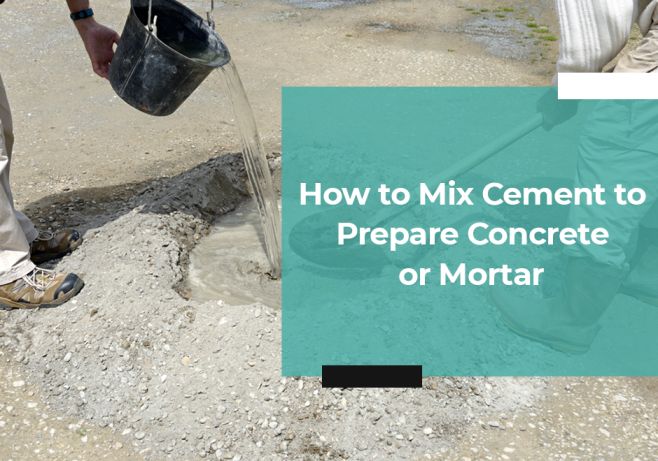Concrete is a full-fledged construction material. It is suitable for the construction of foundations for walls and other masonry constructions. For much smaller tasks, ready-made concrete bags are ideal – all you need to do is add water.
Mortar is a cement and sand mixture that isn’t as strong as concrete but is commonly used as an adhesive for laying down paving flags for patio constructions.
One of the most useful abilities a person may have is the ability to mix cement. People can use concrete to build foundations, walls, floors, paving slabs, patios, general brickwork, and garden walkways, among other things.
You can manufacture your own mortar or concrete mix with the right tools, ingredients, safety equipment, and a little elbow grease, and have it ready to use for your next project.You can mix your own cement for most household projects. It can be worth acquiring a concrete mixer if you’re working on a larger area or a more involved project.
How to Mix Cement:
● Make sure you have enough cement, sand, and stone. The exact ratios will vary based on the type of cement, so check your bag or the instructions that come with your cement for further information. However, as a general rule, one component cement, two parts sand, and four parts stone is required.
● Without the proper safety equipment, cement will allow dust and debris to enter, which can be hazardous. Wear a dust mask, safety glasses, and long-sleeved clothing. When mixing cement, you should also put on a pair of heavy gloves.
● Cement mixing is a messy operation that demands a great deal of attention. Prepare your materials ahead of time. You’ll need cement, sand, and stone, as well as a bucket, wheelbarrow, shovel, or other mixing equipment.
● Put one part cement, two parts sand, and four parts gravel into the wheelbarrow with a tiny spade. Dust and debris will enter the air during the operation, so be sure you’re wearing your dust mask.
● It is best to thoroughly include the dry mix before adding the water. After dumping the cement, sand, and stone into the wheelbarrow, mix the elements together with a shovel or similar instrument until you have an even, consistent mixture.
● Dig a tiny crater in the center of the cement mixture with a shovel. The crater should be around half the pile’s diameter. When finished, the pile should look like a volcano.
● There is no exact amount of water that should be added to the cement. It’s important to add enough to make a smooth paste with a peanut butter-like consistency. To avoid making excessively soupy cement, start small. Fill the crater with a modest amount of water, around half a bucket. Then, with a shovel, stir in the water until it’s entirely absorbed.
● Getting the right consistency will require some trial and error. Gradually add water until users have a hard, spreadable consistency.
How to Mix Cement and Sand:
In a bucket, combine four parts of construction sand and one part cement, then add clean water until the mixture is slightly moist, smooth, and humid. To avoid a wet or sloppy mortar that runs easily off a trowel or jointing instrument, cautiously add water to the mix. The ratio of cement to sand to aggregates in concrete varies depending on the strength desired, but as a general rule, a basic concrete mix is 1 part cement to 2 parts sand to 4 parts of aggregates.
A mixture of 1 part cement, 3 parts sand, and 6 parts aggregates can be used for foundations. Half of the cement, sand, and aggregates should be measured.
How to Mix Cement for Plastering:
For inner brick plastering, mix cement and sand in a 1:6 ratio (1 cement:6 sand). And for the exterior plastering, mix it in a 1:4 ratio. Plastering with a thickness of more than 12 or 15mm should never be done on a brick wall.
How to Mix Cement Mortar:
To build a mortar, combine sand, cement, and water, and then add aggregates to the mix to make concrete. In a large mixing bowl, thoroughly combine all of the ingredients until they achieve the desired consistency. To manufacture mortar or cement, combine the ingredients. To avoid hardening, get cleansing. The volume proportions of 1 water, 2 cement, and 3 sand can be used to make a basic mortar mixture. This basic blend can be used for the majority of student activities.
How to Mix Cement and Ballast:
Aggregate, often known as ballast, is made up of bits of rock like limestone or coarse gravel, as well as other materials like sand. Aggregates that have been recycled are frequently used, and the material can also be pre-manufactured in a blast furnace.
When premixed ballast is required, 6 parts cement to 1 part ballast is required. If all other components are delivered completely dry, the water utilized should be 55 percent of the net weight of the cement. In reality, the materials, particularly the sand, are generally moist.
Check This Out: How Cement is Made? Step by Step Guide

